Relevant Experiences
Assessing and advancing the current state of the science:
- Coordinating Lead Author for the ICIMOD-hosted Himalayan Monitoring and Assessment Programme (HIMAP): Together with Eri Saikawa and Shichang Kang I was responsible for Chapter 10 in The Hindu Kush Himalaya Assessment – Mountains, Climate Change, Sustainability and People, where we assessed the current state of knowledge about air pollution in the Hindukush Himalaya region.
- Guest Editor of the special issue of the journal Atmospheric Environment on South Asian Aerosols And Anthropogenic Emissions: Regional And Global Climate Implications. Together with three other guest editors, oversaw the review and publication of 18 papers that provided insights into the interaction between human emissions, air pollution and climate over South Asia.
- Together with fellow leaders of the SusKat project, I helped convince the editorial board of the journal Atmospheric Chemistry and Physics to publish a special issue that brought together papers on Atmospheric pollution in the Himalayan foothills.
Designing, hosting, and coordinating research projects
- Co-Principal Investigator for the US National Science Foundation funded research project, Nepal Ambient Monitoring and Source Testing Experiment (NAMaSTE): Together with Bob Yokelson (University of Montana), Eri Saikawa (Emory University), Betsy Stone (University of Iowa), Peter DeCarlo (Drexel University / Johns Hopkins), Bill Keene (U. of Virginia), their students, and colleagues at ICIMOD, we quantified emissions from a large number of pollution sources commonly found in South Asia, from diesel pumps to motorcycles, garbage fires, cooking fires and a variety of brick kilns. We also measured real-time aerosol composition at multiple locations as well as from vehicles and cable cars. Data from the project not only supported half a dozen doctoral dissertations, but also provides modelers with much more accurate means to estimate emissions of pollution sources in South Asia.
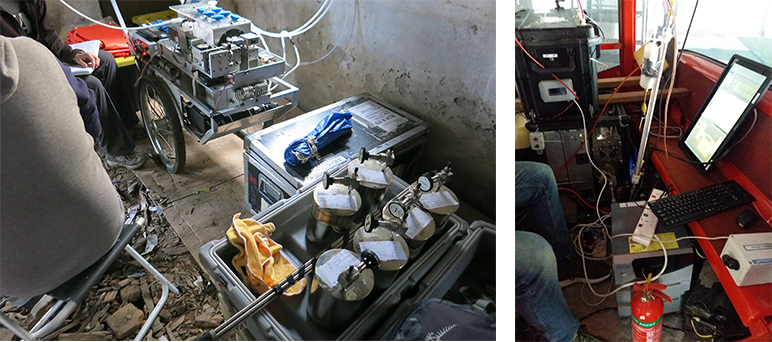
- Together with Brent Holben and Si-Chee Tsay at NASA and colleagues at ICIMOD, I co-designed a satellite-surface-modeling study of pollutant transport from the Indo-Gangetic Plains through the mid-hills to Langtang in the high Himalaya. Several papers from the study are forthcoming.
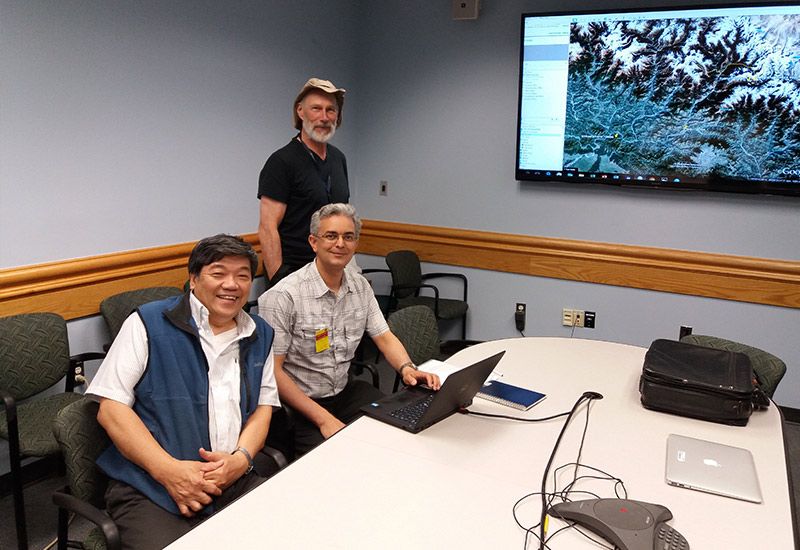
- Recognizing the regional scale and transboundary nature of the persistent winter fog over the Indo-Gangetic Plains that had been increasing over the past two decades, I initiated a 5-country interdisciplinary regional study. Hosted by ICIMOD the study included participating researchers and field sites in Pakistan, India, Nepal, Bhutan and Bangladesh. While we underestimated the challenge of collecting and shipping fog water samples to a central laboratory, we successfully carried out several smaller studies as well as detailed documentation of the fog’s impacts on people’s livelihoods across four countries.

- Working closely with Maheswar Rupakheti at IASS Potsdam, I co-designed and hosted the Sustainable Atmosphere for the Kathmandu Valley (SusKat) field research campaign, bringing to Kathmandu researchers and instruments from Germany, India, China and South Korea to comprehensively understand the science of air pollution in the Kathmandu Valley and its surroundings, while providing numerous research opportunities for doctoral students.
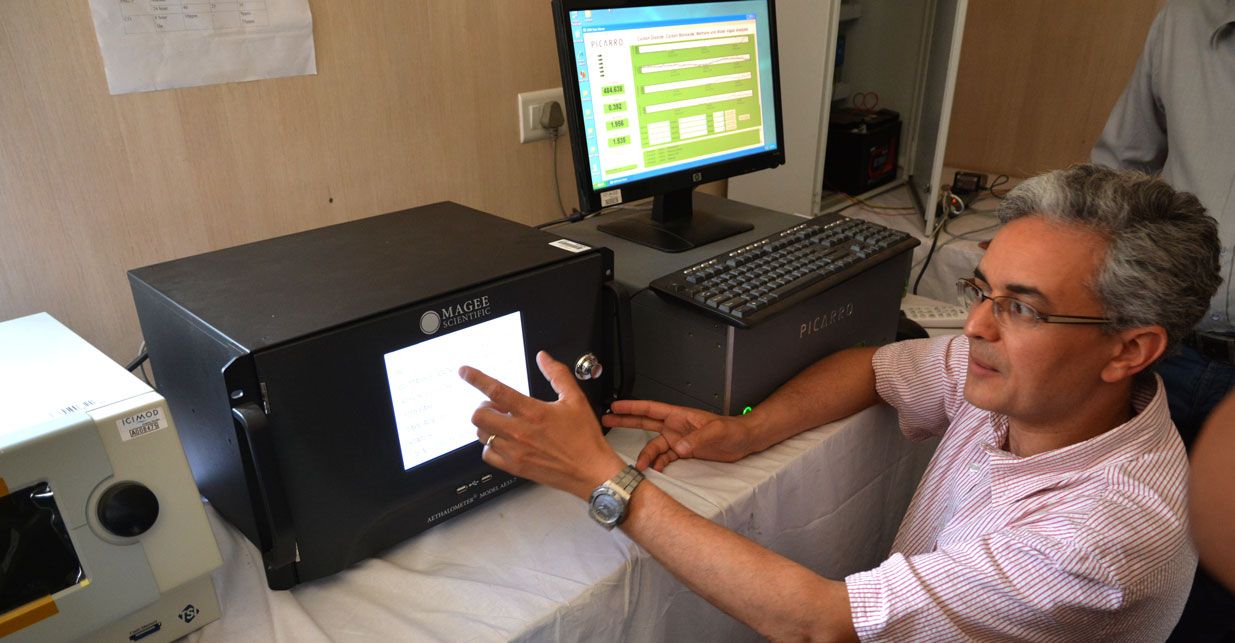
Photo credit: ICIMOD.
- Serving as Co-Investigator with the NASA AERONET aerosol robotic network, I helped create a dataset of aerosol optical depth (“haze thickness”) over Pokhara, Nepal, that has been used in a number of student theses.
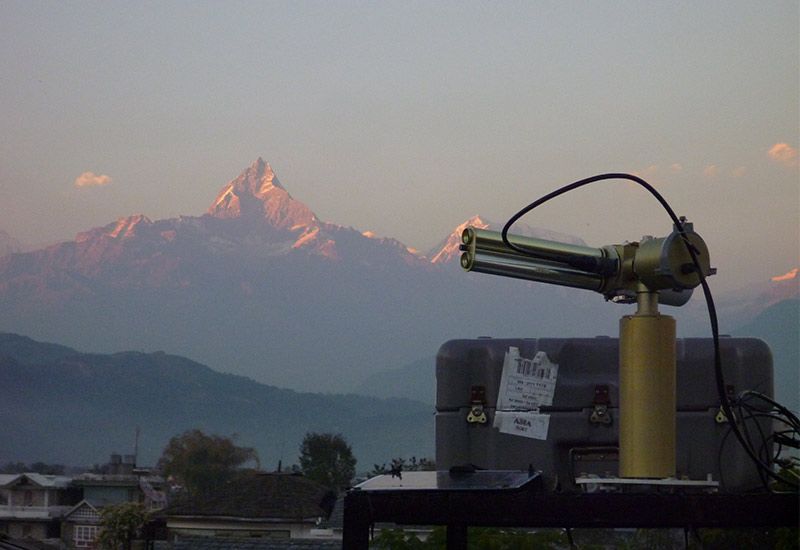
- While at the University of Virginia, I served as a Principal Investigator for the NASA SEAC4RS research project in South and Southeast Asia. I helped plan flight routes for research aircraft, and coordinated field measurements and ozonesonde launches from Nepal that resulted in my student’s doctoral degree.
- As a Research Assistant Professor at the University of Virginia, I initiated and supervised field measurements at several remote locations in Nepal to understand ozone, carbon monoxide and aerosol variations and transport. I also carried out proof-of-concept studies of atmospheric measurements from various mobile platforms in both Virginia and Nepal.
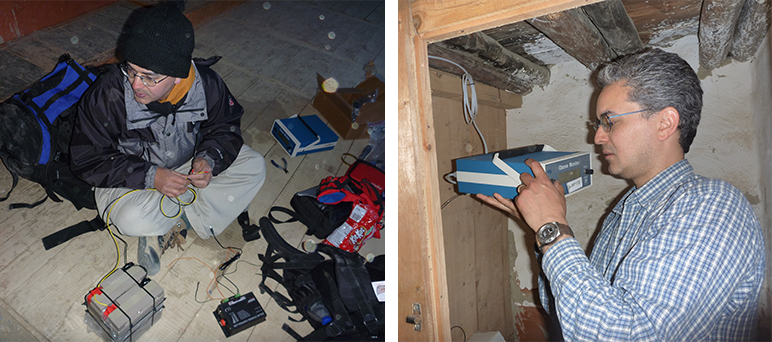
- As a postdoctoral researcher at Princeton University in 2007-2009, I was concerned by the recent discovery of haze layers extending from the Indo-Gangetic Plains deep into the Himalayas. To study possible pathways for air pollutants traveling from the plains to the high mountains I set up and ran high-resolution WRF model simulations of Himalayan meteorology on the super computers of the Geophysical Fluid Dynamics Laboratory.
- As a doctoral student at the Massachusetts Institute of Technology (MIT) I was interested in cutting edge research that would be directly relevant to policymaking: I designed and ran an atmospheric measurement campaign in the Kathmandu Valley in 2004-2005, setting up up a rooftop station where I collected a year of high frequency measurements of CO, ozone, PM10 and weather variables. I also set up portable instruments and collected air samples in a variety of places around the Kathmandu Valley. Earlier I designed and hosted a shorter field measurement campaign with participants from MIT, ETH and Chalmers University using remote sensing instruments. I also designed and wrote code for a single column atmospheric model to examine the impact upon photochemical ozone formation of varying layers of clouds and aerosols, and later ran numerical models (MM5 and CAMx) to simulate airflow and pollution transport in central Nepal.
- As a Master’s student at the University of Wisconsin-Madison, I was worried whether acid rain would impact Himalayan ecosystems: I collected rainwater samples along an east-west transect between Jiri and Pokhara, carried out laboratory analyses for anions and cations and ran the RAINS-ASIA model. Assessing the acid buffering capacity I concluded that the risks of acid rain damage were low in the central Himalayan region.
Relevant Journal Papers
-
Isobel J. Simpson, Barbara Barletta, Simone Meinardi, Omar Siraj Aburizaiza, Peter F. DeCarlo, Muhammad Akhyar Farrukh, Haider Khwaja, Jinseok Kim, Younha Kim, Arnico Panday, Azhar Siddique, Elizabeth A. Stone, Tao Wang, Jung-Hun Woo, Likun Xue, Robert J. Yokelson, Jahan Zeb, and Donald R. Blake. “CFC-11 measurements in China, Nepal, Pakistan, Saudi Arabia, and South Korea (1998-2018): Urban, landfill fire and garbage burning sources” Environmental Chemistry, 18, 370-392. https://doi.org/10.1071/EN21139, 2022.
-
Md. Robiul Islam, Tianyi Li, Khadak Mahata, Nita Khanal, Benjamin Werden, Michael R. Giordano, P. S. Praveen, Narayan Babu Dhital, Anobha Gurung,Arnico K. Panday, , Indu Bikram Joshi, Shankar Prasad Poudel, Yanbo Wang, Eri Saikawa, Robert J. Yokelson, Peter F. DeCarlo, Elizabeth A. Stone. “Wintertime Air Quality in Lumbini, Nepal: Sources of Fine Particle Organic Carbon” ACS Earth and Space Chemistry, sp-2020-00269u, 2021.
-
Saifi Izhar, Tarun Gupta, Adnan Mateen Qadri, Arnico K. Panday. “Wintertime chemical characteristics of aerosol and their role in light extinction during clear and polluted days in rural Indo Gangetic plain” Environmental Pollution, 282. doi.org/10.1016/j.envpol.2021.117034, 2021.
-
Eri Saikawa, Qianru Wu, Min Zhong, Alexander Avramov, Kirpa Ram, Elizabeth A. Stone, Chelsea E. Stockwell, Thilina Jayarathne, Arnico K. Panday, and Robert J. Yokelson.“Garbage Burning in South Asia: How Important Is it to Regional Air Quality?” Environmental Science & Technology, 54, 16, 9928–9938, doi.org/10.1021/acs.est.0c02830, 2020.
-
Md. Robiul Islam, Thilina Jayarathne, Isobel J. Simpson, Benjamin Werden, John Maben, Ashley Gilbert, Puppala S. Praveen, Sagar Adhikari, Arnico K. Panday, Maheswar Rupakheti, Donald R. Blake, Robert J. Yokelson, Peter F. DeCarlo, William C. Keene, and Elizabeth A. Stone, “Ambient air quality in the Kathmandu Valley, Nepal during the pre-monsoon: Concentrations and sources of particulate matter and trace gases”, Atmospheric Chemistry and Physics, 20, 2927-2951, https://doi.org/10.5194/acp-20-2927-2020, 2020.
-
Jeevan Regmi, Khem N Poudyal, Amod Pokhrel, Madhu Gyawali, Lekhendra Tripathee, Arnico Panday, Anthony Barinelli, Rudra Aryal.“Investigation of Aerosol Climatology and Long-Range Transport of Aerosols over Pokhara, Nepal”, Atmosphere, 11, 874; doi:10.3390/atmos11080874, 2020.
-
Pengfei Chen, Shichang Kang, Lekhendra Tripathee, Kirpa Ram, Maheswar Rupakheti,Arnico K. Panday, Qianggong Zhang, Junming Guo, Xiaoxiang Wang, Tao Pu, Chaoliu Li,“Light absorption properties of elemental carbon (EC) and watersoluble brown carbon (WSeBrC) in the Kathmandu Valley, Nepal: A 5- year study”, Environmental Pollution, 261, 114239, doi.org/10.1016/j.envpol/2020.114239, 2020.
-
Pengfei Chen, Shichang Kang, Lekhendra Tripathee,Arnico K. Panday, Maheswar Rupakheti, Dipesh Rupakheti, Qianggong Zhang, Junming Guo, Chaoliu Li, Tao Pu “Severe air pollution and characteristics of light-absorbing particles in a typical rural area of the Indo-Gangetic Plain”, Environmental Science and Pollution Research, 27, 10617-10628, doi.org/10.1007/s11356-020-07618-6, 2020.
-
Manisha Mehra, Arnico K. Panday, Siva Praveen Puppala, Vikrant Sapkota, Bhupesh Adhikary, Chiranjibi P. Pokharel, Kirpa Ram. “Impact of local and regional emission sources on air quality in foothills of the Himalaya during spring 2016: An observation, satellite and modeling perspective”, Atmospheric Environment, 216, doi: 10.1016/j.atmosenv.2019.116897, 2019.
-
Min Zhong, Eri Saikawa, Alexander Avramov, Chen Chen, Boya Sun, Wenlu Ye, William C. Keene, Robert J. Yokelson, Thilina Jayarathne, Elizabeth A. Stone, Maheswar Rupakheti, and Arnico K. Panday, Siva Praveen Puppala, Vikrant Sapkota, Bhupesh Adhikary, Chiranjibi P. Pokharel, Kirpa Ram. “Nepal Ambient Monitoring and Source Testing Experiment (NAMaSTE): emissions of particulate matter and sulfur dioxide from vehicles and brick kilns and their impacts on air quality in the Kathmandu Valley, Nepal”, Atmospheric Chemistry and Physics, 19, 8209–8228, https://doi.org/10.5194/acp-19-8209-2019, 2019.
-
Saifi Izhar, Tarun Gupta, Aliva P. Mintz, Shantibhusan Senapati, Arnico Panday, Siva Praveen Puppala, Vikrant Sapkota, Bhupesh Adhikary, Chiranjibi P. Pokharel, Kirpa Ram. “Influence of regional and long-range transport air masses on fog water composition, contribution and toxicological response at Indo Gangetic Plain”, Atmospheric Environment, 214, 116888, 2019.
-
Dipesh Rupakheti, Shichang Kang, Maheswar Rupakheti, Zhiyuan Cong, Arnico K. Panday, Brent N. Holben, “Identification of absorbing aerosol types at a site in the northern edge of Indo-Gangetic Plain and a polluted valley in the foothills of the central Himalayas”, Atmospheric Research, 223, 15-23, https://doi.org/10.1016/j.atmosres.2019.03.003, 2019.
- Xin Wan, Shichang Kang, Maheswar Rupakheti, Qianggong Zhang, Lekhendra Tripathee, Junming Guo, Pengfei Chen, Dipesh Rupakheti, Arnico Panday, Mark Lawrence, Kimitaka Kawamura, Zhiyuan and Cong, “Molecular characterization of organic aerosols in the Kathmandu Valley, Nepal: Insights into primary and secondary sources”, Atmospheric Chemistry and Physics, 19, 2725-2747, https://doi.org/10.5194/acp-19-2725-2019, 2019.
- Ashish Singh, Khadak S. Mahata, Maheswar Ruphaketi, Wolfgang Junkermann, Arnico K. Panday, Mark G. Lawrence. “An overview of airborne measurement in Nepal – Part 1: Vertical profile of aerosol size, number, spectral absorption, and meteorology” Atmospheric Chemistry and Physics, 19, 245-258, https://doi.org/10.5194/acp-19-245-2019, 2019.
-
Dipesh Rupakheti, Nguyen Thi Kim Oanh, Maheswar Rupakheti, Ram Kumar Sharma, Arnico K. Panday,Siva Praveen Puppala, Mark G. Lawrence. “Indoor levels of black carbon and particulate matters in relation to cooking activities using different cook stove-fuels in rural Nepal”, Energy for Sustainable Development, 48, 25-33, doi 10.1016/j.esd.2018.10.007, 2019.
- Parth Sarathi Mahapatra, Siva Praveen Puppala, Bhupesh Adhikary, Kundan L. Shrestha, Durga Prasad Dawadi, Shankar Prasad Paudel, Arnico K. Panday. “Air quality trends of the Kathmandu Valley: A satellite, observation and modeling perspective”. Atmospheric Environment, 201, 334-347. doi 10.1016/j.atmosenv.2018.12.043, 2019.
- J. Douglas Goetz, Michael R. Giordano, Chelsea E. Stockwell, Ted J. Christian, Rashmi Maharjan, Sagar Adhikari, Prakash V. Bhave, Puppala S. Praveen, Arnico K. Panday, Thilina Jayarathne, Elizabeth A. Stone, Robert J. Yokelson, and Peter F. DeCarlo. “Speciated online PM1 from South Asian combustion sources – Part 1: Fuel-based emission factors and size distributions”. Atmospheric Chemistry and Physics, 18, 14653-14679, https://doi.org/10.5194/acp-18-14653-2018, 2018.
- Khadak Singh Mahata, Maheswar Rupakheti, Arnico Kumar Panday, Piyush Bhardwaj, Manish Naja, Ashish Singh, Andrea Mues, Paolo Cristofanelli, Deepak Pudasainee, Paolo Bonasoni, and Mark G. Lawrence. “Observation and analysis of spatio-temporal characteristics of surface ozone and carbon monoxide at multiple sites in the Kathmandu Valley Nepal”. Atmospheric Chemistry and Physics, 18, 14113-14132, https://doi.org/10.5194/acp-18-14113-2018, 2018.
- Dipesh Rupakheti, Shichang Kang, Maheswar Rupakheti, Zhiyuan Cong, Lekhendra Tripathee, Arnico K. Panday, Brent N. Holben. “Observation of optical properties and sources of aerosols at Buddha’s Birthplace, Lumbini, Nepal: Environmental and climate implications“. Environmental Science and Pollution Research, 25, 14868-14881. doi 10.1007/s11356-018-1713-z, 2018.
- Piyush Bhardwaj, Manish Naja, Maheswar Rupakheti, Arnico K. Panday, Rajesh Kumar, Khadak Mahata, Shyam Lal, Harish C. Chandola, Mark G. Lawrence. “Variations in surface ozone and carbon monoxide in the Kathmandu Valley and surrounding broader regions during SusKat‐ABC field campaign: Role of local and regional sources” Atmospheric Chemistry and Physics, 18, 11949-11971, https://doi.org/10.5194/acp-18-11949-2018, 2018.
- Thilina Jayarathne, Chelsea E. Stockwell, Prakash V. Bhave, Puppala S. Praveen, Chathurika M. Rathnayake, Md. Robiul Islam, Arnico K. Panday, Sagar Adhikari, Rasmi Maharjan, J. Doug Goetz, Peter F. DeCarlo, Eri Saikawa, Robert J. Yokelson, and Elizabeth A. Stone. “Nepal Ambient Monitoring and Source Testing Experiment (NAMaSTE): Emissions of particulate matter from wood and dung cooking fires, brick kilns, generators, trash and crop residue burning.” Atmospheric Chemistry and Physics, 18, doi 10.5194/acp-18-2259-2018, 2018.
- Shradda Dhungel, Bhogendra Kathayat, Khadak Mahata, andArnico Panday. “Transport of regional pollutants through a remote trans-Himalayan valley in Nepal”. Atmospheric Chemistry and Physics, 18, doi:10.5194/acp-18-1203-2018, 2018.
- Sujan Shrestha, Siva Praveen Puppala, Bhupesh Adhikary, Kundan Lal Shrestha, and Arnico K. Panday. “Field Measurements for Quantifying Semi-Volatile Influence on Physical and Optical Properties of Ambient Aerosols in the Kathmandu Valley”. Aerosol and Air Quality Research, doi:10.4209/aaqr.2017.11.0492, 2017.
- Khadak Singh Mahata, Arnico Kumar Panday,Maheswar Rupakheti, Manish Naja, Mark G. Lawrence. “Seasonal and diurnal variations of methane and carbon dioxide in the Kathmandu Valley in the foothills of the central Himalaya”.Atmospheric Chemistry and Physics, 17, doi 10.5194/acp-17-12573-2017, 2017.
- Chaeyoon Cho, Sang-Woo Kim, Maheswar Rupakheti, Jinsoo Park, Arnico Panday, Soon-Chang Yoon, Ji-Hyoung Kim, Hyunjae Kim, Haeun Jeon, Minyoung Sung, Bong Mann Kim, Seunkyu Hong, Rokjin Park, Dipesh Rupakheti, Khadak Singh Mahata, Siva Praveen Puppala, Mark G. Lawrence and Brent Holben. “Wintertime Aerosol Optical and Radiative Properties in the Kathmandu Valley during the SusKat-ABC Field Campaign”. Atmospheric Chemistry and Physics, 17, doi 10.5194/acp-2017-239, 2017.
- Dipesh Rupakheti, Bhupesh Adhikary, Puppala S. Praveen, Maheswar Rupakheti, Shichang Kang, Khadak S. Mahata, Manish Naja, Qianggong Zhang, Arnico Panday and Mark Lawrence. “Pre-monsoon air quality over Lumbini, a world heritage site along the Himalayan foothills”. Atmospheric Chemistry and Physics, 17, 11041-11063, doi 10.5194/acp-17-11041-2017, 2017.
- Xin Wan, Shichang Kang, Quanlian Li, Dipesh Rupakheti, Qianggong Zhang, Junming Guo, Penfei Chen, Lekhendra Tripathee, Maheswar Rupakheti, Arnico K. Panday, Wu Wang, Kimitaka Wakamura, Shaopeng Gao, Guangming Wu, Zhiyuan Cong. “Organic molecular tracers in the atmospheric aerosols from Lumbini, Nepal, in the northern Indo-Gangetic Plain: Influence of biomass burning”. Atmospheric Chemistry and Physics, 17, 8867-8885. doi 10.5194/acp-17-8867-2017, 2017.
-
Junming Guo, Shichang Kang, Jie Huang, Qianggong Zhang, Maheswar Rupakheti, Shiwei Sun, Lekhendra Tripathee, Dipesh Rupakheti, Arnico K. Panday, Mika Sillanpää, Rukumesh Paudyal. “Characterization of atmospheric particulate mercury in the capital city of Nepal, South Asia. Science of the Total Environment, 579, 1240-1248. doi 10.1016/ scitotenv.2016.11.110, 2017.
-
Chinmoy Sarkar, Vinayak Sinha, Baerbel Sinha, Arnico K. Panday, Maheswar Rupakheti, Mark G. Lawrence. “Source apportionment of NMVOCs in the Kathmandu Valley during the SusKat-ABC international field campaign using positive matrix factorization”. Atmospheric Chemistry and Physics, 17, 8129-8156, doi 10.5194/acp-17-8129-2017, 2017.
-
Kabindra Shakya, Maheswar Rupakheti, Anima Shahi, Rejina Maskey, Bidya Pradhan, Arnico Panday, Siva. P. Puppala, Mark Lawrence and Richard Peltier. “Near-road sampling of PM2.5, BC, and fine particle chemical components in Kathmandu Valley, Nepal”. Atmospheric Chemistry and Physics, 17, 6503-61516, doi 10.5194/acp-2016-1027, 2017.
- Chelsea E. Stockwell, Ted J. Christian, J. Douglas Goetz, Thilina Jayarathne, Prakash V. Bhave, Puppala S. Praveen Sagar Adhikari, Rashmi Maharjan, Peter F. DeCarlo, Elizabeth A. Stone, Eri Saikawa, Donald R. Blake, Isobel J. Simpson, Robert J. Yokelson, and Arnico K. Panday. “Nepal Ambient Monitoring and Source Testing Experiment (NAMaSTE): Emissions of trace gases and light-absorbing carbon from wood and dung cooking fires, garbage and crop residue burning, brick kilns, and other sources”. Atmospheric Chemistry and Physics, 16, 11043-11081, 2016.
-
Chinmoy Sarkar, Vinayak Sinha, Vinod Kumar, Maheswar Rupakheti, >Arnico Panday, Khadak S. Mahata, Dipesh Rupakheti, Bhogendra Kathayat, and Mark G. Lawrence. “Overview of VOC emissions and chemistry from PTR-TOF-MS measurements during the SusKat-ABC campaign: high acetaldehyde, isoprene and isocyanic acid in wintertime air of the Kathmandu Valley”. Atmospheric Chemistry and Physics, 16, 3979-4003, doi.org/10.5194/acp-16-3979-2016, 2016.
-
K. Krishna Moorthy, S K. Satheesh, M. M. Sarin, Arnico K. Panday. “Editorial: South Asian aerosols in perspective: Preface to the special issue”. Atmospheric Environment, 125, 307-311, 2016.
- Charles Gertler, PS Praveen, Arnico Panday, Dorothea Stumm and Joe Shea. “Black carbon and the Himalayan cryosphere: A review” Atmospheric Environment, 125, 404-417, 2016.
-
D. Putero, P. Cristofanelli, A. Marinoni, B. Adhikary, R. Duchi, S. D. Shrestha, G. P. Verza, T. C. Landi, F. Calzolari, M. Busetto, G. Agrillo, F. Biancofiore, P. Di Carlo,A. K. Panday, M. Rupakheti, and P. Bonasoni. “Seasonal variation of ozone and black carbon observed at Paknajol, an urban site in the Kathmandu Valley, Nepal”. Atmospheric Chemistry and Physics, 15, 13957-13971, 2015.
- Bong Mann Kim, Jin-Soo Park, Sang-Woo Kim, Hyunjae Kim, Haeun Jeon, Chaeyoon Cho, Ji-Hyoung Kim, Seungkyu Hong, Maheswar Rupakheti, Arnico K. Panday, Rokjin J. Park, Jihyung Hong, Soon-Chang Yoon. “Source apportionment of PM10 mass and particulate carbon in the Kathmandu Valley, Nepal”. Atmospheric Environment, 123, 190-199, 2015.
- C. Xu, Y. M. Ma, A. Panday, Z. Y. Cong, K. Yang, Z. K. Zhu, J. M. Wang, P. M. Amatya, L. Zhao, “Similarities and differences of aerosol optical properties between southern and northern sides of the Himalayas.” Atmospheric Chemistry and Physics, 14, 3133-3149, 2014.
- Bonasoni, P. P. Laj, A. Marinoni, A., M. Sprenger, F. Angelini, J. Arduini, U. Bonafè, F. Calzolari, T. Colombo, S. Decesari, C. Di Biagio, A.G.di Sarra, F. Evangelisti, R. Duchi, C. Facchini, S. Fuzzi, GP. Gobbi, M. Maione, A. Panday, F.Roccato, K. Sellegri, H. Venzac, GP. Verza, P. Villani, E. Vuillermoz and P. Cristofanelli, P. Cristofanelli. “Atmospheric Brown Clouds in the Himalayas: first two years of continuous observations at the Nepal-Climate Observatory at Pyramid (5079 m)”. Atmospheric Chemistry and Physics, 10, 7515-7531, 2010.
- Panday, Arnico K., and Ronald G. Prinn. “The diurnal cycle of air pollution in the Kathmandu Valley, Nepal: Observations”. Journal of Geophysical Research – Atmospheres, 114, D09305, doi: 10.1029/2008JD009777, 2009.
- Panday, Arnico K., Ronald G. Prinn, and Christoph Schär. “The diurnal cycle of air pollution in the Kathmandu Valley, Nepal: Part 2, Modeling results”. Journal of Geophysical Research – Atmospheres, 114, D21308, doi:10.1029/ 2008JD009808, 2009.
- Yu, Yong, Bo Galle, Elke Hodson, Arnico Panday, Ronald Prinn, and Shuhui Wang. “Observations of high NO2 – HONO conversion in the nocturnal atmospheric boundary layer in Kathmandu, Nepal”. Atmospheric Chemistry and Physics, 9, 6401–6415, 2009.
- Yu, Yong, Arnico Panday, Elke Hodson, Bo Galle, and Ronald Prinn. “Monocyclic aromatic hydrocarbons in Kathmandu during the winter season”. Water, Air and Soil Pollution. doi: 10.1007/s11270-007-9607-6, 2007.
- Panday, Arnico. 2006. The Diurnal Cycle of Air Pollution in the Kathmandu Valley, Nepal. Center for Global Change Science Report Series # 75, Massachusetts Institute of Technology, Cambridge, MA.
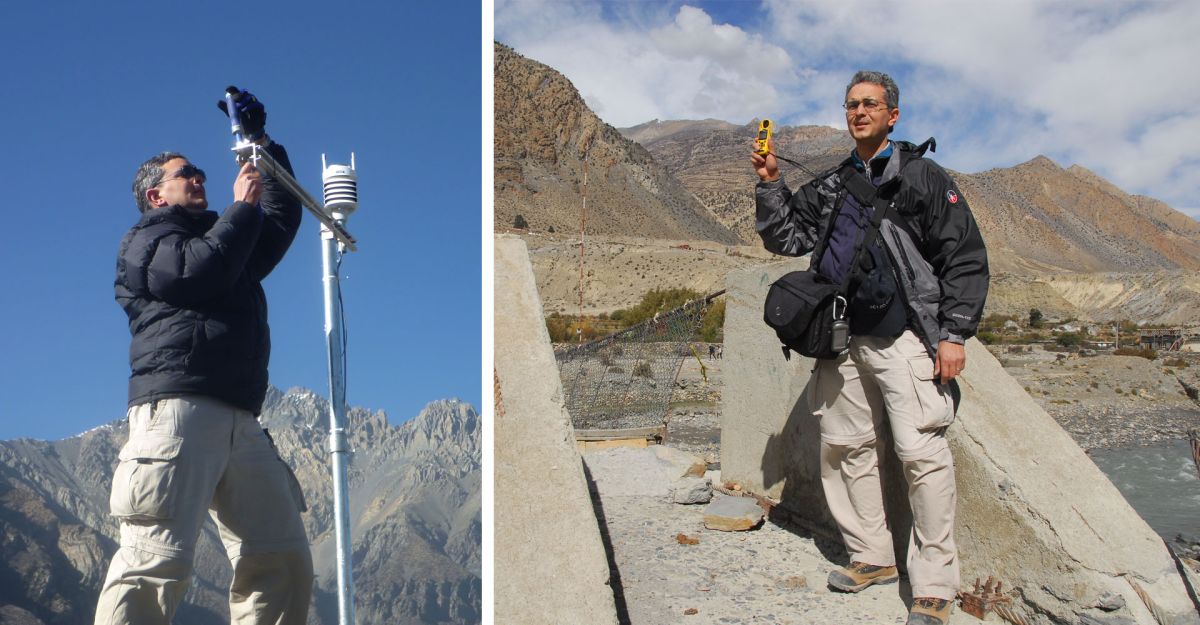
Relevant Seminars / Lectures / Talks
-
Aryabhatta Research Institute of Observational Sciences, Inaugural Keynote at the International Conference on Aerosol Air Quality, Climate Change and Impact on Water Resources and Livelihoods in the Greater Himalaya [presented remotely], Nainital, India, 14 September 2020. “Aerosols and air quality across the Greater Himalayas: Emerging regional understanding and priorities for the decade ahead” [Available on Youtube: https://www.youtube.com/watch?v=5b7y_G1e7pk&t=5895s]
-
Paul Scherrer Institut, Invited Seminar, Villigen, Switzerland, 13 June 2019, “Air pollution research and mitigation in the Hindukush Himalaya”
Third International Workshop on Atmospheric Composition and the Asian Monsoon (ACAM), workshop presentation, Guangzhou, China, 7 June, 2017. “New observatories, new data, and new insights on air pollution in the Himalaya”
-
Atmospheric Brown Cloud Science Team Meeting Presentation, Bangkok, Thailand, 25 November 2015. “Atmospheric Measurements in Nepal and Bhutan”
-
Massachusetts Institute of Technology, Seminar. Cambridge, MA, USA, 27 July 2015. “Atmospheric Research in the Himalaya: The Role of ICIMOD’s Atmosphere Initiative”
-
International Global Atmospheric Chemistry Project Asia Working Group Meeting presentation. Bangkok, Thailand, 2 March 2015. “Atmospheric Chemistry Research in Nepal”
-
AdaptHKH Conference, Panel Presentation. Kathmandu, Nepal, 10 November 2014. “Black Carbon and other atmospheric pollutants: Key scientific knowledge gap”
-
Asia Oceania Geosciences Society (AOGS) Annual Meeting, Invited Presentation, Sapporo, Japan, 29 July 2014. “Observations and Modeling of Haze over the Himalaya”
-
ETH Institute for Atmosphere and Climate, Extraordinary Seminar, Zurich, Switzerland, 28 March, 2014. “Building up atmospheric research in the Himalaya”
-
American Geophysical Union Annual Meeting. Oral Presentation. San Francisco, CA, USA. 9 December 2013. “Improving SLCF Science in the Himalayan Region: ICIMOD’s Atmosphere Initiative”
-
NASA Jet Propulsion Laboratory, Invited Seminar, Pasadena, CA, USA, 30 July 2013, “Atmospheric Research in the Nepal Himalaya”
-
International Workshop on Atmospheric Composition and the Asian Summer Monsoon (ACAM), Oral Presentation, Kathmandu, Nepal, 11 June 2013. “Pollution transport to the Tibetan Plateau by up-valley winds”
-
University of Virginia, Department of Environmental Sciences, Atmospheric Science Seminar. Charlottesville, VA, USA, 28 October 2011. “Atmospheric measurement adventures in the Himalaya, on the Himalaya, over the Himalaya”
-
Atmospheric Brown Cloud Science Team Meeting, Presentation, Kathmandu, Nepal, 24 March 2011. “New observatories and aircraft soundings in the Annapurna Himalaya”
-
NASA Goddard Space Flight Center, Seminar, Greenbelt, MD, USA, 28 September 2010. “Atmospheric Science Field Measurements in the Nepal Himalaya”
-
Massachusetts Institute of Technology, Department of Earth, Atmospheric and Planetary Sciences Special Seminar, Cambridge, MA, USA, 12 May 2010, “Canaries or Chimneys? The Role of the Himalaya in Regional and Global Atmospheric Chemistry and Climate Change”
-
University of Virginia, Department of Environmental Sciences, Seminar, Charlottesville, VA, USA 7 May 2009. “Air Pollution in the Himalaya: Observations, Implications, and Unknowns.”
-
European Geosciences Union General Assembly Session 3.5, Vienna, Austria, 23 April 2008, “Do the Himalaya Export Pollutants from the Ganges Basin?” (EGU2009-11081)
-
National Taiwan University, Department of Atmospheric Sciences¸ Invited Seminar, Taipei, Taiwan, 6 April 2009. “Local and Regional Air Pollution in the Himalaya”
-
Rutgers University, Department of Environmental Sciences, Environmental Science Seminar. New Brunswick, NJ, USA, 11 March 2009. “Air Pollution and Climate Change in the Himalaya: Interactions, Unknowns, and Future Directions”
-
International Centre for Integrated Mountain Development, Seminar, Kathmandu, Nepal, 11 July 2008, “Air Pollution, Haze, and Climate Change in the Himalaya Region”
-
European Geosciences Union General Assembly Session 3.5, Vienna, Austria, 15 April 2008, “Vertical Transport of Air Pollution in the Himalaya.” (EGU2008-A-00783)
-
University of Houston Department of Geosciences, Invited Presentation, Houston, TX, USA, 27 February 2008. “Local and Regional Air Pollution in the Himalaya.”
-
American Geophysical Union Fall 2007 Meeting, San Francisco, CA, USA, 14 December 2007, “Basin by Night and Plateau By Day: Air Pollution Accumulation and Ventilation in the Kathmandu Valley, Nepal.” (AGU A51G-04)
-
École Polytechnique Fédérale de Lausanne, LMCA Seminar, Lausanne, Switzerland, 5 July 2007. “The Diurnal Cycle of Air Pollution in the Kathmandu Valley, Nepal”
-
Max Planck Institute for Chemistry, Atmospheric Chemistry Seminar, Mainz, Germany, 2 July 2007. “A Field and Modeling Study of Air Pollution in the Kathmandu Valley, Nepal”
-
Geophysical Fluid Dynamics Laboratory, Seminar, Princeton, NJ, USA, 28 June 2007. “Air Pollution in the Himalaya: In the Kathmandu Valley and From the Ganges Plains”
-
University of Houston, Institute for Multidimensional Air Quality Studies, Seminar, Houston, TX, USA, 22 June 2007. “A Field and Modeling Study of Air Pollution in the Kathmandu Valley, Nepal”
-
University of Wisconsin, Center for Sustainability and the Global Environment, Seminar, Madison, WI, USA, June 18, 2007. “The Diurnal Cycle of Air Pollution in the Kathmandu Valley, Nepal”
-
Pennsylvania State University, Department of Meteorology, Special Seminar, State College, PA, USA, May 3, 2007. “The Diurnal Cycle of Air Pollution in the Kathmandu Valley, Nepal.”
-
Georgia Institute of Technology, School of Earth and Atmospheric Sciences, Seminar, Atlanta, GA, USA, April 6, 2007. “Measurements and Modeling of Air Pollution in the Kathmandu Valley, Nepal”
-
ETH Institute for Atmospheric and Climate Science Aussergewöhnliches Seminar, Zürich, Switzerland, December 22, 2006. “Observations and Modeling of Air Pollution in the Kathmandu Valley, Nepal”
-
Asian Institute of Technology, School for Energy, Resources and Development, Seminar, Bangkok, Thailand, August 29, 2006. “The Diurnal Cycle of Air Pollution in the Kathmandu Valley, Nepal”
-
MIT Dept. of Earth, Atmospheric and Planetary Sciences, Doctoral Defense Lecture, Cambridge, MA, USA, April 26, 2006. “The Diurnal Cycle of Air Pollution in the Kathmandu Valley, Nepal”
-
ETH Institute for Atmospheric and Climate Science. Schär Group meeting presentation, Zürich, Switzerland, February 27, 2002. “Air Pollution in the Kathmandu Valley, Nepal: Hypothesized Effects of Topography.”
-
MIT Department of Earth Atmospheric and Planetary Sciences, Oral Presentation, Cambridge, MA, USA, May 17, 2001: “Radiative Transfer Effects of Clouds and Aerosols on Urban Photochemistry: A modeling study of the Kathmandu Valley, Nepal”
Relevant courses attended
-
The AtmosphereHarvard College
-
Introduction to Quantitative MethodsHarvard College
-
Multivariable CalculusHarvard College
-
Applied Mathematics / Differential EquationsHarvard College
-
Linear Algebra and Differential EquationsHarvard College
-
Applied Mathematical AnalysisU. of Wisconsin
-
Foundations of ChemistryHarvard College, taught by Nobel Laureate Dudley Hershbach
-
Principles of Organic ChemistryHarvard College
-
Atmospheric ChemistryHarvard College
-
Physical ChemistryU. of Wisconsin
-
Atmospheric ChemistryMIT, taught by Nobel Laureate Mario Molina
-
Physics – MechanicsHarvard College
-
Geophysical Fluid DynamicsU. of Wisconsin
-
Fluid Dynamics of Atmosphere and OceanMIT & Woodshole Institute of Oceanography
-
Atmospheric PhysicsMIT
-
Wave Motions: Ocean and AtmosphereMIT & Woodshole Institute of Oceanography
-
General Circulation of the Earth’s AtmosphereMIT
-
Large-scale Flow Dynamics LaboratoryMIT
-
Quasi-balanced CirculationsMIT
-
Tropical MeteorologyMIT
-
Special Problems: MeteorologyMIT
-
MM5 Model Tutorial1 week course, National Center for Atmospheric Research, USA
-
CMAQ Model Tutorial1 week course, US EPA / UNC Chapel Hill
